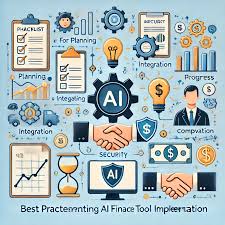In the ever-evolving landscape of finance, the integration of artificial intelligence has become increasingly significant, particularly in the realm of financial reporting. Businesses are constantly seeking ways to improve accuracy, efficiency, and insights derived from their financial data. This is where ai-powered financial reporting tools come into play, revolutionizing how organizations manage and analyze their financial information.
Overview of AI-Powered Financial Reporting Tools
Ai-powered financial reporting tools utilize advanced algorithms and machine learning techniques to streamline the process of generating financial reports. These tools help finance professionals automate repetitive tasks, analyze large datasets, and derive actionable insights from financial information. By leveraging AI, organizations can enhance their reporting capabilities, allowing for quicker decision-making and a more strategic approach to financial management.
Key Features and Benefits of AI in Financial Reporting
The benefits of using financial reporting tools powered by AI are numerous and impactful. Here are some of the key features that these tools typically offer:
1. Automation of Data Entry and Reporting
One of the most significant advantages of ai-powered financial reporting tools is their ability to automate data entry and report generation. This reduces the time spent on manual processes and minimizes the risk of human error, leading to more accurate financial reporting.
2. Enhanced Data Analysis
These tools can process large volumes of data at incredible speeds, allowing for sophisticated analysis that would be challenging for humans to perform manually. By identifying patterns and trends within financial data, organizations can make more informed decisions and discover opportunities for growth.
3. Real-Time Insights
With the integration of AI, financial reporting tools can provide real-time insights into an organization’s financial health. This immediacy allows businesses to respond quickly to changing conditions, ensuring they remain agile and competitive.
4. Predictive Analytics
Many ai-powered financial reporting tools come equipped with predictive analytics capabilities. This feature enables businesses to forecast future financial outcomes based on historical data, assisting in budgeting and strategic planning efforts.
5. Enhanced Compliance and Risk Management
Compliance with financial regulations is crucial for any business. AI tools help in monitoring transactions and ensuring adherence to financial standards, thus mitigating risks associated with non-compliance.
Top AI-Powered Financial Reporting Tools in the Market
Several tools stand out in the market for their robust features and user-friendly interfaces. While the choice of tool may depend on specific business needs, here are a few notable options:
1. Tool A
Tool A is known for its intuitive dashboard and powerful data visualization capabilities. Users often praise its ease of use and the ability to generate comprehensive reports quickly.
2. Tool B
With a focus on automation, Tool B excels in minimizing manual input and streamlining workflows. Case studies show that companies using Tool B have significantly reduced reporting time while increasing accuracy.
3. Tool C
Tool C offers advanced analytics features, including predictive modeling. Users report that this tool has enhanced their ability to forecast budgets and make strategic decisions.
When evaluating these tools, it’s essential to consider user reviews and how each tool has performed in real-world scenarios. This feedback can provide valuable insights into the effectiveness and reliability of the software.
Practical Tips for Choosing the Right Tool
Choosing the right ai-powered financial reporting tools involves several considerations:
- Assess Your Needs: Determine the specific financial reporting requirements of your organization. Are you looking for automation, advanced analytics, or compliance features?
- Consider Scalability: Ensure the tool can grow with your business. As your financial reporting needs evolve, the tool should be able to adapt.
- Evaluate User Experience: A user-friendly interface can significantly impact adoption rates among your finance team.
- Request Demos: Take advantage of free trials or demos to evaluate how well the tool meets your needs before making a commitment.
As businesses navigate the complexities of financial reporting, embracing ai-powered financial reporting tools can provide a competitive edge. By automating processes, enhancing analysis, and delivering real-time insights, these tools empower organizations to make informed financial decisions with confidence. For those seeking to explore effective solutions in this space, resources and further insights can be found at Incite AI.
Top AI-Powered Financial Reporting Tools in the Market
Several tools stand out in the market for their robust features and user-friendly interfaces. While the choice of tool may depend on specific business needs, here are a few notable options:
1. Tool A
Tool A is known for its intuitive dashboard and powerful data visualization capabilities. Users often praise its ease of use and the ability to generate comprehensive reports quickly.
2. Tool B
With a focus on automation, Tool B excels in minimizing manual input and streamlining workflows. Case studies show that companies using Tool B have significantly reduced reporting time while increasing accuracy.
3. Tool C
Tool C offers advanced analytics features, including predictive modeling. Users report that this tool has enhanced their ability to forecast budgets and make strategic decisions.
When evaluating these tools, it’s essential to consider user reviews and how each tool has performed in real-world scenarios. This feedback can provide valuable insights into the effectiveness and reliability of the software.
